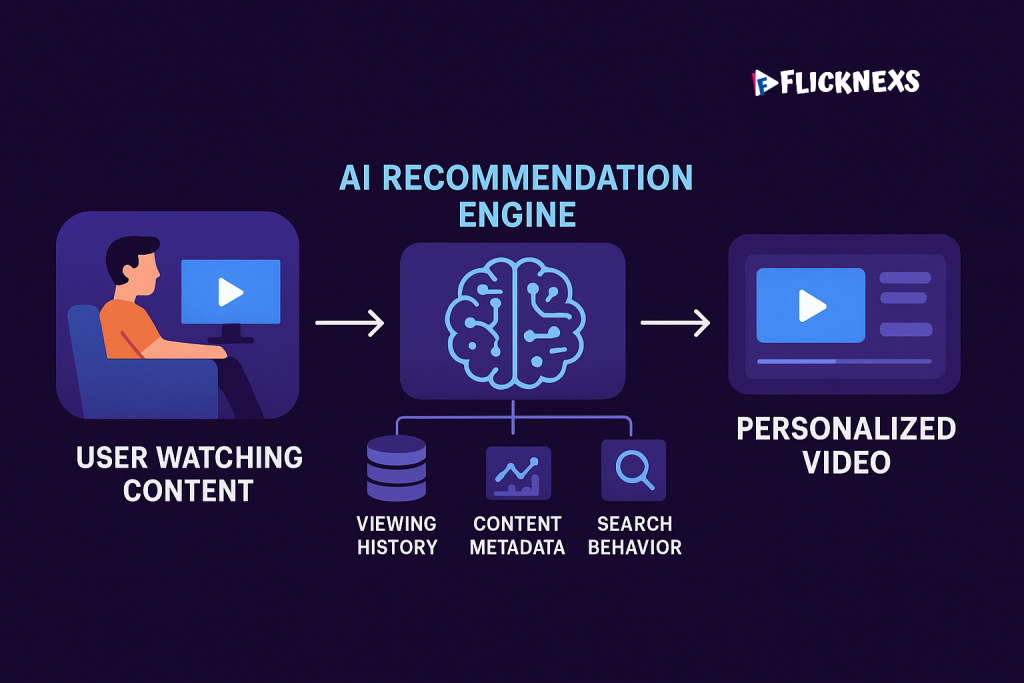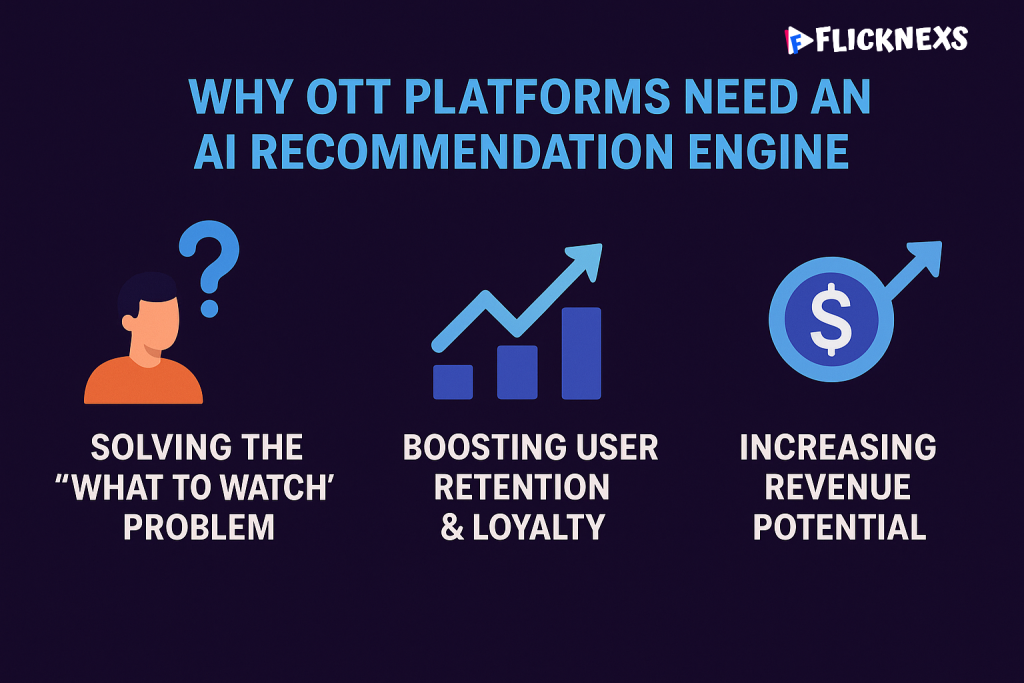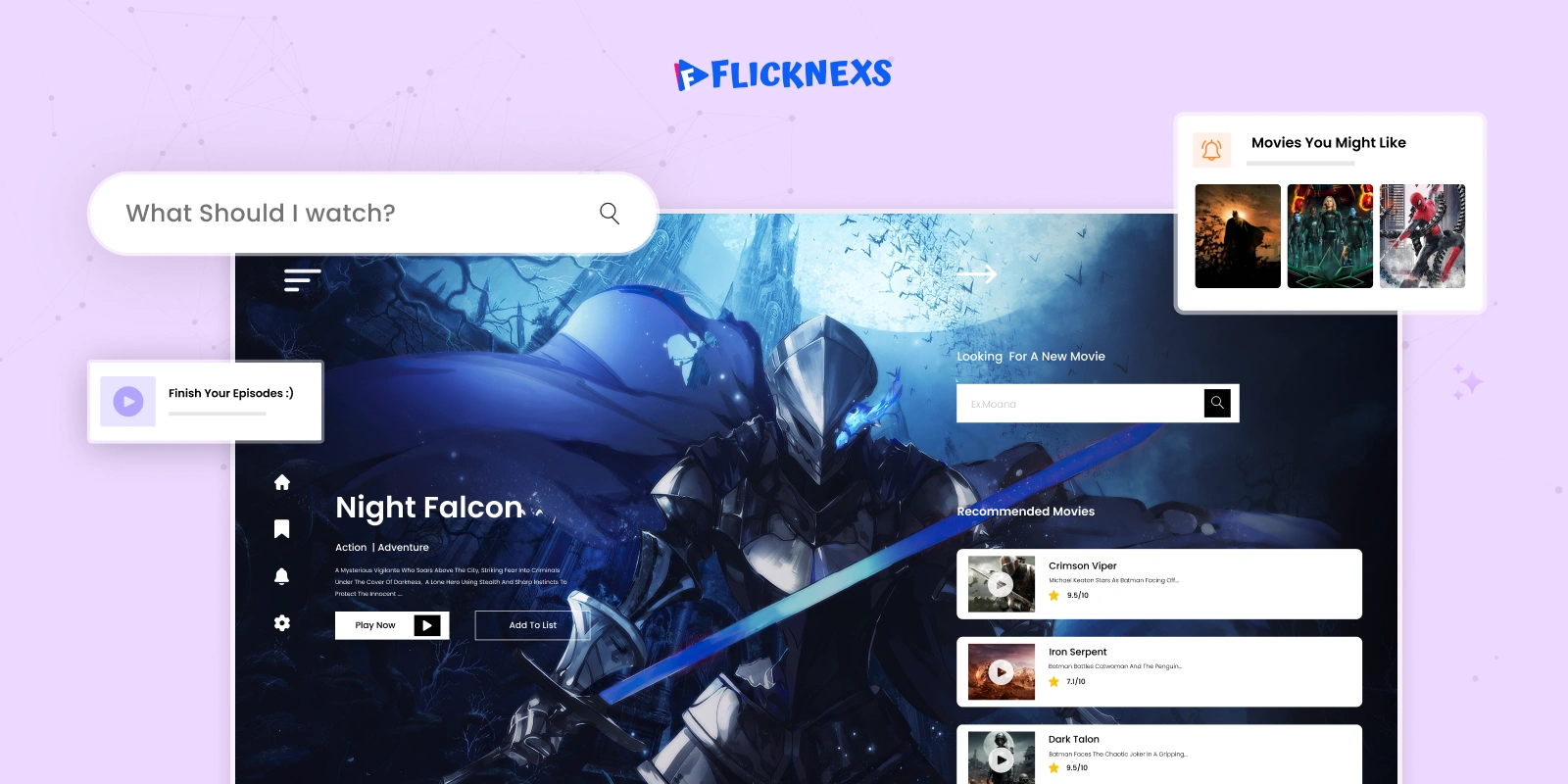Many OTT viewers often struggle with the classic “what should I watch?” dilemma. With thousands of titles on platforms like Netflix, Disney+, or Amazon Prime Video, users can get overwhelmed. This leads to decision fatigue and reduces engagement.
An AI recommendation engine solves this by analyzing each viewer’s preferences, viewing patterns, and interactions. It predicts what content a user is most likely to enjoy, increasing watch time, retention, and ultimately revenue. AI helps OTT platforms not only serve the right content at the right time but also gain insights into user behavior, improving long-term strategy.
What is an AI Recommendation Engine for OTT?
Definition & Core Functionality
An AI recommendation engine is software that uses artificial intelligence and machine learning to suggest content tailored to individual users. Unlike traditional systems, which might recommend content based solely on popularity, AI considers:
- User behavior: Watch history, search queries, click patterns.
- Content metadata: Genre, actors, duration, release date, ratings.
- Engagement patterns: How long users watch content, skip behavior, or rewatch habits.
This personalization ensures that users see content that resonates with them, improving the overall viewing experience.
Example: Netflix’s algorithm combines collaborative filtering (what users with similar tastes liked) and deep learning (analyzing patterns beyond basic metrics) to suggest shows and movies.
How It Works

AI recommendation engines operate using several layers:
- Content Metadata Analysis: The system categorizes content based on attributes like genre, cast, storyline, and release date.
- User Behavior Tracking: The engine monitors what users watch, how long they watch, search queries, likes/dislikes, and interactions.
- Machine Learning Models: Algorithms predict what content a user is most likely to enjoy next. Models continuously learn from new data, improving accuracy over time.
Example: If a user frequently watches sci-fi movies with a female lead, the engine might recommend similar sci-fi titles with strong female protagonists, even if the user hasn’t explicitly searched for them.
Why OTT Platforms Need an AI Recommendation Engine

Solving the “What to Watch” Problem
Viewers often feel overwhelmed by the sheer volume of content. AI recommendation engines reduce this decision fatigue by narrowing options to the most relevant content. This keeps users engaged and improves satisfaction.
Example: Amazon Prime Video may suggest a mix of trending shows and titles similar to what the user has previously watched, instead of leaving them to scroll endlessly.
Boosting User Retention & Loyalty
Personalized recommendations keep users coming back. When viewers discover content they enjoy quickly, they are more likely to:
- Stay subscribed to the platform.
- Spend more time watching content.
- Share their experience with friends, generating organic growth.
Impact: Increased retention directly affects revenue, as retaining an existing subscriber is cheaper than acquiring a new one.
Increasing Revenue Potential
AI recommendation engines help monetize content better:
- Subscription renewals: Engaged users are less likely to cancel.
- Upselling premium content: Suggesting higher-tier content encourages upgrades.
- Ad targeting (for AVOD models): Personalized recommendations can improve ad relevance and click-through rates.
Example: Disney+ can push newly released premium movies to users who previously watched similar films, increasing purchase rates.
Key Benefits of AI Recommendation Engines for OTT Businesses
An AI recommendation engine is much more than a “suggestion tool.” For OTT platforms, it is a strategic growth driver that improves user experience, engagement, and revenue. Here’s a detailed breakdown of the benefits:
1. Personalized Content Discovery
AI allows platforms to serve content tailored to each user’s tastes, making every viewing session feel custom-made. By analyzing past watch history, search queries, likes/dislikes, and even the time spent on each title, AI predicts what a user will likely enjoy next.
Impact:
- Users spend less time searching and more time watching.
- Platforms can recommend niche or long-tail content that may not be widely popular but resonates with specific audiences.
Example: If a user frequently watches romantic comedies, the engine can suggest new or lesser-known rom-coms, improving satisfaction and engagement.
2. Higher Engagement Metrics (Watch Time & Click-Through Rates)
AI-powered recommendations encourage users to explore more content and spend longer on the platform. When suggestions align closely with user interests:
- Watch time increases, which is a key metric for OTT performance.
- Click-through rates (CTR) for recommended content rise because viewers are more likely to choose what appeals to them.
Example: Netflix reports that over 80% of the content watched comes from its recommendation system, showing how AI directly impacts engagement.
3. Reduced Churn Rate
When users consistently find content they love, they are less likely to unsubscribe. AI recommendation engines provide a personalized experience that builds loyalty and reduces attrition.
How it helps:
- Retains subscribers who might otherwise leave due to boredom or dissatisfaction.
- Encourages users to explore new genres and content types, keeping the platform fresh and engaging.
Example: Disney+ can re-engage subscribers who haven’t watched in a while by suggesting trending shows similar to their past preferences.
4. Data-Driven Content Acquisition Decisions
AI doesn’t just help users—it helps businesses. By analyzing what users watch, skip, or rate highly, OTT platforms can make informed decisions on content acquisition and production.
Benefits:
- License shows or movies that match viewer demand.
- Produce original content that has a higher chance of success.
- Reduce investment in underperforming content.
Example: Netflix’s hit series often stem from analyzing viewing patterns to identify genres or storylines with high engagement potential.
5. Enhanced Monetization Opportunities
AI recommendations can directly contribute to revenue generation:
- Subscription Models (SVOD): Engaged users are more likely to renew subscriptions.
- Transactional Models (TVOD): Recommend premium content that users are likely to purchase.
- Advertising Models (AVOD): Personalized content can be paired with targeted ads for higher conversion rates.
Example: Prime Video can suggest a paid movie to a user who frequently streams free content in similar genres, increasing revenue potential.
6. Improved User Retention Through Predictive Analytics
AI engines can predict when a user is likely to churn and proactively recommend content to re-engage them. This predictive approach helps platforms retain subscribers before they leave, increasing lifetime customer value.
7. Competitive Advantage in a Crowded Market
OTT is highly competitive, with dozens of platforms vying for attention. Platforms with AI-driven personalization can differentiate themselves by offering:
- Unique, tailored viewing experiences
- Higher engagement than competitors without AI
- Smarter content strategies informed by real user data
Example: A smaller OTT platform using AI may compete with Netflix by offering highly personalized content suggestions, even with a smaller library.
8. Continuous Learning and Improvement
AI systems constantly learn from user interactions, improving over time:
- The more a user interacts with the platform, the better the recommendations.
- Algorithms adapt to seasonal trends, new releases, and changing user preferences.
Impact: Users always feel the platform understands their tastes, leading to sustained engagement.
9. Scalability for Growing Platforms
As an OTT platform grows, AI can scale effortlessly:
- Handles thousands or millions of users simultaneously.
- Offers personalized recommendations without manual effort.
- Maintains consistent user experience even as the content library expands.
Real-World Examples of AI in OTT Platforms
AI recommendation engines are not just theoretical—they are already shaping how viewers consume content across leading OTT platforms. Here’s a deeper look into how major players implement AI:
Netflix – Collaborative Filtering & Deep Learning
Netflix is the gold standard for AI-driven recommendations. They use collaborative filtering, which analyzes what similar users have watched, combined with deep learning models that detect complex patterns in viewing behavior.
- Personalized Rows: Each user sees a unique homepage with content tailored to their interests.
- Dynamic Thumbnails: Netflix even tests multiple thumbnails for the same title to see which image increases click-through rates for each user.
- Impact: Netflix claims that over 80% of viewer activity comes from personalized recommendations, demonstrating how AI drives engagement and reduces churn.
Amazon Prime Video – Hybrid Recommendation Models
Amazon Prime Video leverages hybrid recommendation models, combining:
- Content-based filtering: Suggests titles similar to what the user has watched.
- Behavioral data: Considers watch history, search queries, ratings, and even watch duration.
- Real-time personalization: Updates recommendations instantly based on current user activity.
Impact: This approach increases discoverability of lesser-known content while keeping users engaged with a mix of trending and personalized suggestions.
Disney+ – AI-Powered Content Clustering
Disney+ uses AI-powered content clustering, grouping movies and shows into clusters based on themes, genres, and user behavior.
- Suggests content based on viewing patterns rather than just popularity.
- Integrates metadata and machine learning to identify niche interests, such as superhero movies, animated classics, or family-friendly content.
- Helps in cross-promotion, e.g., recommending Marvel shows to viewers who watched other superhero content.
Hulu – Contextual & Mood-Based Recommendations
Hulu focuses on contextual AI recommendations, which not only consider past behavior but also factors like:
- Time of day (suggesting light content in the morning and binge-worthy shows in the evening)
- Device used (TV vs mobile)
- User mood inferred from viewing patterns (action-packed content vs calm drama)
Impact: Increases user satisfaction by delivering the right content at the right moment.
YouTube & YouTube TV – Predictive Content Discovery
YouTube’s recommendation engine relies heavily on predictive analytics:
- Tracks clicks, watch duration, likes/dislikes, and comments.
- Suggests trending videos while adapting to individual preferences.
- Continuously updates suggestions as users interact, creating an evolving feed.
Impact: Drives extremely high engagement, with recommendations accounting for a significant portion of total watch time.
Smaller OTT Platforms Using AI (Case Study Example)
Even smaller platforms like Shudder (horror-focused) or Crunchyroll (anime) are using AI recommendations:
- Shudder suggests movies based on horror sub-genres like slasher, supernatural, or psychological thrillers.
- Crunchyroll tracks viewing patterns to recommend anime series tailored to user taste, improving binge-watch sessions.
Key Takeaway: AI isn’t just for giant platforms. Even niche OTT providers can implement AI engines to improve personalization, boost engagement, and retain subscribers.
How to Implement an AI Recommendation Engine in Your OTT Platform
Implementing an AI recommendation engine isn’t just about installing software—it’s a strategic process that requires careful planning, high-quality data, and ongoing optimization. Here’s a detailed roadmap:
Step 1 – Identify and Collect Your Data Sources
The foundation of any AI recommendation engine is data. The more accurate and diverse your data, the better your AI can predict user preferences.
- User Interaction Data: Track watch history, clicks, search queries, play/pause behavior, and watch duration.
- Content Metadata: Include genre, actors, directors, language, release date, duration, ratings, and tags.
- User Feedback: Collect ratings, likes/dislikes, reviews, and surveys.
- Contextual Data: Device type, location, time of day, and subscription tier can influence recommendations.
Best Practice: Use a centralized data warehouse to store and manage data efficiently. Ensure compliance with privacy regulations like GDPR or CCPA to maintain user trust.
Example: Netflix combines millions of user interaction events daily to feed its recommendation engine.
Step 2 – Choose the Right Recommendation Model
AI engines rely on machine learning models to generate predictions. The choice of model depends on your data, platform scale, and business goals.
- Collaborative Filtering:
- Recommends content based on similar user behavior.
- Example: “Users who watched X also watched Y.”
- Pros: Works well when user interaction data is rich.
- Cons: Cold-start problem for new users or new content.
- Recommends content based on similar user behavior.
- Content-Based Filtering:
- Suggests content similar to what a user has already watched, based on metadata.
- Pros: Works well for new users (cold start).
- Cons: Can lead to narrow recommendations, lacking variety.
- Suggests content similar to what a user has already watched, based on metadata.
- Hybrid Models:
- Combines collaborative and content-based filtering to leverage the strengths of both.
- Example: Amazon Prime Video uses hybrid models for personalized recommendations.
- Pros: Balances accuracy and diversity, reduces cold-start issues.
- Combines collaborative and content-based filtering to leverage the strengths of both.
Tip: Experiment with multiple models and measure performance using engagement metrics like watch time, CTR, and retention rates.
Step 3 – Integrate AI with Your OTT Infrastructure
Integrating AI with your platform requires a seamless connection between backend, frontend, and recommendation engine:
- API Integration: Use APIs to fetch recommendations in real-time for each user session.
- Personalized UI Elements: Highlight recommended content on the homepage, “Continue Watching” sections, or push notifications.
- Scalable Architecture: Use cloud services (AWS, Azure, Google Cloud) to ensure the engine handles millions of concurrent users efficiently.
Example: Disney+ integrates AI directly into its mobile and TV apps to show personalized carousels based on individual user behavior.
Best Practice: Ensure low latency for real-time recommendations to avoid delays in content display.
Step 4 – Monitor, Test, and Optimize Continuously
AI is not “set and forget.” Continuous monitoring and optimization are critical:
- Track KPIs: Watch time, click-through rate (CTR), churn rate, and recommendation acceptance rate.
- A/B Testing: Experiment with different recommendation strategies to identify what works best.
- Feedback Loop: Use real-time data to retrain models regularly for improved accuracy.
- Balance Personalization and Discovery: Avoid over-personalization, which may limit content diversity.
Example: Netflix constantly tests multiple algorithms and UI layouts to see which recommendations increase engagement most effectively.
Step 5 – Ensure Data Privacy and Compliance
AI engines require sensitive user data. Maintaining privacy is critical:
- Encrypt user data in transit and at rest.
- Provide clear privacy policies and allow users to control their data.
- Comply with global data protection regulations (GDPR, CCPA, etc.).
Tip: Platforms that prioritize privacy can increase user trust and engagement.
Step 6 – Plan for Future Scaling
As your OTT platform grows, the AI recommendation engine should evolve with it:
- Handle More Data: Incorporate new user behavior patterns and content types.
- Support Multiple Languages/Regions: Provide personalized recommendations for a global audience.
- AI-Driven Insights for Business Decisions: Use AI data to guide content acquisition, licensing, and production strategies.
Example: Amazon Prime Video leverages AI not only for recommendations but also to predict which content will attract new subscribers in different regions.
Common Mistakes to Avoid When Using AI for Recommendations
Implementing an AI recommendation engine can significantly improve engagement and revenue, but there are common pitfalls that OTT platforms must avoid to ensure success:
1. Ignoring Data Privacy & Compliance
Many platforms focus heavily on personalization but overlook data privacy regulations like GDPR, CCPA, or local privacy laws. Collecting and using personal data without proper consent can lead to legal issues and loss of user trust.
Best Practices:
- Obtain explicit consent for data collection.
- Anonymize user data wherever possible.
- Regularly audit data handling processes to stay compliant.
2. Over-Personalization Leading to Limited Choices
AI engines that focus too narrowly on user preferences may limit exposure to new or diverse content. This can lead to “content bubbles”, where users only see a narrow range of shows or movies, which may eventually reduce engagement.
Best Practices:
- Include “exploration” or “discovery” sections in recommendations.
- Mix personalized suggestions with trending or new releases.
- Periodically rotate content to maintain variety and surprise users.
3. Not Testing Models Regularly
AI algorithms are not “set and forget.” OTT platforms often make the mistake of implementing a model once and not updating or testing it, resulting in outdated or less accurate recommendations over time.
Best Practices:
- Conduct A/B testing to measure recommendation effectiveness.
- Continuously retrain machine learning models with new user data.
- Monitor engagement metrics like watch time, click-through rate, and churn to evaluate performance.
4. Relying Solely on One Recommendation Model
Some OTT platforms use only collaborative filtering or content-based filtering, which may not capture the full range of user preferences. A single model can miss nuances in user behavior.
Best Practices:
- Use hybrid models combining collaborative, content-based, and contextual recommendations.
- Leverage advanced techniques like deep learning for better predictions.
5. Ignoring Edge Cases and New Users
New users with little or no watch history can be challenging for AI engines. Platforms that ignore this “cold start” problem risk providing irrelevant recommendations and losing potential subscribers.
Best Practices:
- Use demographic, contextual, or trending content for new users.
- Encourage onboarding activities, such as surveys or content ratings, to quickly gather preferences.
6. Overlooking Business Goals
Focusing solely on personalization without aligning recommendations with business objectives can be a mistake. For example, promoting only popular content may maximize engagement but not revenue from premium content.
Best Practices:
- Align AI recommendations with monetization strategies (e.g., upselling premium content).
- Balance user satisfaction with business KPIs like subscriptions, retention, and ad revenue.
Conclusion
An AI recommendation engine for OTT platforms is essential to stay competitive. By offering personalized content, increasing engagement, reducing churn, and driving revenue growth, AI transforms the viewer experience and boosts business performance. Investing in AI isn’t just about technology—it’s about creating long-term growth and customer satisfaction.



Leave a Reply